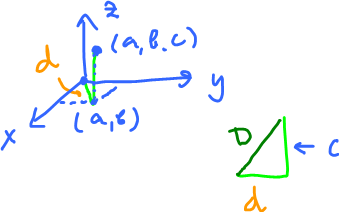This site is being phased out.
Dot product
How do we compute distances and angles in vector spaces?
Plan: Take a vector space and equip it with extra structure, so that we can measure.
To understand how, let's observe that we do measure in ${\bf R}^1$, ${\bf R}^2$, ${\bf R}^3$, etc. How?
Consider the distance formula in ${\bf R}^2$.
Which is $$d=\sqrt{(a-u)^2+(b-v)^2},$$ that comes from Pythagorean Theorem.
In ${\bf R}^3$ also:
we have $$D=\sqrt{(a-u)^2+(b-v)^2+(c-w)^2}$$ etc.
Then, the distance from $d=(a,b)$ to $0$ is $\sqrt{a^2+b^2}$. $$D^2=d^2+c^2 = a^2+b^2+c^2,$$ diagonal of box $a \times b \times c$.
In ${\bf R}^n$ distance formula is the following.
The distance between $a=(a_1,\ldots,a_n)$ and $b=(b_1,\ldots,b_n)$ is $$d(a,b)=\sqrt{(a_1-b_1)^2+\ldots+(a_n-b_n)^2}.$$ (it's a number!)
We can measure vectors and, therefore, can consider convergence:
- given $x_i \in {\bf R}^n$, $x_i \rightarrow a \in {\bf R}^n$ if distance from $x_i$ to $a$ goes to $0$ as $i \rightarrow \infty$, i.e.,
$$\displaystyle\lim_{i \rightarrow \infty} d(x_i,a)=0.$$
With this you can introduce limits, continuity, derivative, integral, the rest of calculus. So, we have calculus in ${\bf R}^n$ (not just ${\bf R}^3$ as in calc 3). It's called vector calculus.
Another measurement in the Euclidean space is angles.
Suppose we have $u,v \in {\bf R}^2$, so that $u=(u_1,u_2), v=(v_1,v_2)$.
Known formula: $$\cos \alpha=\frac{u_1v_1+u_2v_2}{\sqrt{u_1^2+u_2^2}\sqrt{v_1^2+v_2^2}}.$$ Here we identify the top to be the dot product of $u,v \in {\bf R}^2$ and the bottom is the norms of $u$ and $v$.
It is better notation then: $$= \frac{ < u,v > } {\lVert u \rVert \lVert v \rVert}.$$ Observation: no mention of dimension!
But does the angle between two vectors even make sense in ${\bf R}^n$?
Given $u,v \in {\bf R}^n$, what is the meaning of "the angle between vectors"?
First, we know what it is in ${\bf R}^2$.
Now, consider ${\bf R}^3$.
In ${\bf R}^3$, we make a plane $P={\rm span}\{u,v\}$ (the dimension is 2, a plane). Then we can measure the angle between these vectors -- within $P$!
Similar for ${\bf R}^n$.




